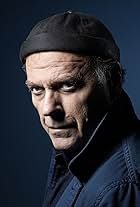Enki Bilal
- Director
- Writer
- Art Department
Born in Yugoslavia, his mother was Czech and his Bosnian father used to
be Tito's tailor. His family fled the country to France in 1960, where
Enki learns French and discovers cinema and comic books. In 1971, he
wins a contest organized by the famous comics magazine Pilote with his
first story "L'appel des étoiles". It's published in Pilote and later
re-released under the title "Le bol maudit", and it allows Enki Bilal
to start working for the magazine by drawing politicians. He then meets
Pierre Christin (at the time scenarist of "Valérian" for Pilote) and starts his
collaboration with him in 1975 with "La croisières des oubliés". In
1979, they release "Les Phalanges de l'Ordre Noir", which receives
great critics and a Prix RTL. Bilal also draws "Exterminateur 17" in
1978 for magazine Metal Hurlant, with a scenario by Jean-Pierre Dionnet (later
released as an album in 1989).
Enki Bilal releases his first solo comic book, "La foire aux immortels", in 1980, which is the first episode of his famous "Nikopol Trilogy" (followed by "La Femme piège" in 1986 and "Froid équateur" in 1993, which will be the first comic book to be chosen as best book of the year by the litterature magazine Lire). He also designs the poster for Alain Resnais's _Mon onlce d'Amérique (1980)_. Two years later he collaborates with Resnais again but not only for the poster: he also imagines the costumes and creates a part of the production design of Life Is a Bed of Roses (1983), using glass painting technics. He also continues his collaboration with Christin for Dargaud Editions, mainly releasing "Partie de Chasse", which receives many eulogistic critics in the French press in 1983. In 1985, he makes some graphic researches for Jean-Jacques Annaud 's The Name of the Rose (1986). He then meets Patrick Cauvin (aka Patrick Cauvin) with whom he collaborates for "Hors jeu" (1986), book of texts and illustrations on the theme of sports. In 1987, he receives the prestigious First Prize at the comic books festival of Angoulême. The year after, he exhibits his work at the Palais de Tokyo (Paris), among works of photographer Josef Koudelka and artist Guy Peellaert.
The next step in his cinema ambitions is Bunker palace hôtel (1989), his first film as a director, co-written with Christin, starring Jean-Louis Trintignant and Carole Bouquet. He also works for the first time for stage shows, creating the costumes and production design of Denis Levaillant's contemporary opera "OPA mia" in Avignon in 1990, and for Sergei Prokofiev's ballet "Roméo et Juliette » (choreographed by Angelin Preljocaj) in Lyon in 1991. After some few album releases or re-releases and exhibitions ("Transit" at the Grande Arche de la Défense in Paris in 1992; "Bleu Sang" in Paris in 1994), Bilal directs his second film, Tykho Moon (1996), again starring Trintignant, but also Julie Delpy, Michel Piccoli and Richard Bohringer. This time, the scenario is co-written by Dan Franck and the music is composed by Goran Vejvoda. Bilal also releases a graphic book based on his movie. In 1998, he starts a new trilogy with "Le Sommeil du montre" (Editions Les Humanoïdes Associés), then the graphic book "Un siècle d'amour" with Dan Franck in 1999, "Le Sarcophage" with Christin in 2000 and the second episode of his trilogy, "Trente-deux Décembre", in 2003. He also makes several exhibitions: "Magma" (Naples, 2000), "Le Sarcophage" (Paris, 2000), "enkibilalandeuxmilleun" (Paris, 2001, then Sarajevo, Belgrade, Lièges, Cherbourg and Barcelona).
Producer Charles Gassot, who's a fan of Bilal's work, decides to produce a risky project and allows Bilal to have a bigger budget (about 22 millions Euros) for his new film: Immortal (2004). The movie is based on the first two episodes of the "Nikopol Trilogy" and Bilal asks sci-fi writer Serge Lehman to help him for the scenario. The film is a daring combination of digital and live characters, featuring Linda Hardy, Thomas Kretschmann and Charlotte Rampling. Bilal also casts Jean-Louis Trintignant, Frédéric Pierrot and Yann Collette for the third time, and Vejvoda for the music again.
Enki Bilal releases his first solo comic book, "La foire aux immortels", in 1980, which is the first episode of his famous "Nikopol Trilogy" (followed by "La Femme piège" in 1986 and "Froid équateur" in 1993, which will be the first comic book to be chosen as best book of the year by the litterature magazine Lire). He also designs the poster for Alain Resnais's _Mon onlce d'Amérique (1980)_. Two years later he collaborates with Resnais again but not only for the poster: he also imagines the costumes and creates a part of the production design of Life Is a Bed of Roses (1983), using glass painting technics. He also continues his collaboration with Christin for Dargaud Editions, mainly releasing "Partie de Chasse", which receives many eulogistic critics in the French press in 1983. In 1985, he makes some graphic researches for Jean-Jacques Annaud 's The Name of the Rose (1986). He then meets Patrick Cauvin (aka Patrick Cauvin) with whom he collaborates for "Hors jeu" (1986), book of texts and illustrations on the theme of sports. In 1987, he receives the prestigious First Prize at the comic books festival of Angoulême. The year after, he exhibits his work at the Palais de Tokyo (Paris), among works of photographer Josef Koudelka and artist Guy Peellaert.
The next step in his cinema ambitions is Bunker palace hôtel (1989), his first film as a director, co-written with Christin, starring Jean-Louis Trintignant and Carole Bouquet. He also works for the first time for stage shows, creating the costumes and production design of Denis Levaillant's contemporary opera "OPA mia" in Avignon in 1990, and for Sergei Prokofiev's ballet "Roméo et Juliette » (choreographed by Angelin Preljocaj) in Lyon in 1991. After some few album releases or re-releases and exhibitions ("Transit" at the Grande Arche de la Défense in Paris in 1992; "Bleu Sang" in Paris in 1994), Bilal directs his second film, Tykho Moon (1996), again starring Trintignant, but also Julie Delpy, Michel Piccoli and Richard Bohringer. This time, the scenario is co-written by Dan Franck and the music is composed by Goran Vejvoda. Bilal also releases a graphic book based on his movie. In 1998, he starts a new trilogy with "Le Sommeil du montre" (Editions Les Humanoïdes Associés), then the graphic book "Un siècle d'amour" with Dan Franck in 1999, "Le Sarcophage" with Christin in 2000 and the second episode of his trilogy, "Trente-deux Décembre", in 2003. He also makes several exhibitions: "Magma" (Naples, 2000), "Le Sarcophage" (Paris, 2000), "enkibilalandeuxmilleun" (Paris, 2001, then Sarajevo, Belgrade, Lièges, Cherbourg and Barcelona).
Producer Charles Gassot, who's a fan of Bilal's work, decides to produce a risky project and allows Bilal to have a bigger budget (about 22 millions Euros) for his new film: Immortal (2004). The movie is based on the first two episodes of the "Nikopol Trilogy" and Bilal asks sci-fi writer Serge Lehman to help him for the scenario. The film is a daring combination of digital and live characters, featuring Linda Hardy, Thomas Kretschmann and Charlotte Rampling. Bilal also casts Jean-Louis Trintignant, Frédéric Pierrot and Yann Collette for the third time, and Vejvoda for the music again.









